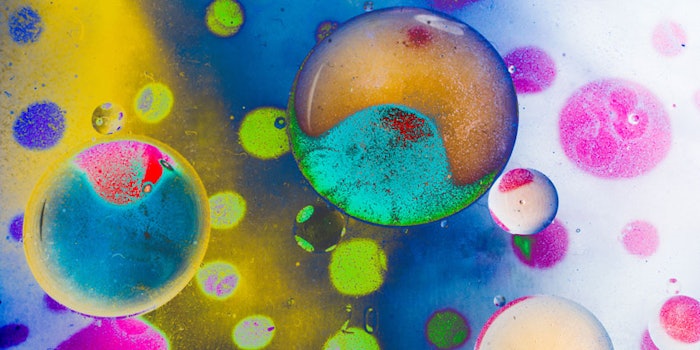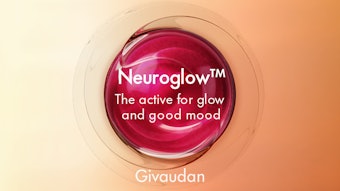
Various emulsion types have been developed throughout the history of the cosmetic industry. Due to their ability to solubilize relatively large amounts of water-insoluble ingredients, i.e., emollients and fragrances, and provide long-term stability, microemulsions have been a suitable vehicle in various skin care applications. Microemulsions have long assisted the pharmaceutical industry in delivering efficacious levels of an active ingredient to the skin by enhancing the active’s bioavailability, versus traditional solutions and dispersions.1 An example of this technology is seen in the immunosuppressant drug cyclosporina, commonly used to treat psoriasis and rheumatoid arthritis.
These novel vehicles soon made their transition for many skin care applications, where they provide luxurious aesthetics as well as outstanding stability. The benefit of these microemulsions has been identified for various skin care applications such as moisturization, cleansing, sunscreen and antiperspirants. Their advantage over conventional formulations to introduce lipophilic and hydrophilic actives to the skin or hair has proved to be beneficial.
Besides their benefits, microemulsions also differentiate themselves visually. Due to their ability to produce transparent and translucent products, they have been used to develop clear and blueish tinted lotions, gels or serums. Another advantage is that these emulsions also limit the need for solvents that may dry the skin.
This article will review the basic chemistry, application techniques and formulating issues using microemulsions.
Surfactant Structures
Surfactant chemistry is one of the main foundations of the personal care industry. The unique hydrophilic-hydrophobic parts within a surfactant molecule make these amphiphilic structures strongly surface active. One key attribute of surfactant structure is the ability to self-associate to form micelles. The concentration where micelle formation occurs is usually well-defined and referred to as the critical micelle concentration (CMC). This field has been thoroughly explored, and the reader is encouraged to review works by Shinoda and Lindman2 and Friberg and Lindman,3 among others.
Therefore, it can be perplexing, that with decades of research on complex surfactant systems, application of these systems is still in its infancy. Traditional emulsions and micellar solutions are easily found in everyday life, from foods to cleaning products to cosmetics. However, surfactant structures such as lamellar liquid crystals, vesicles, liposomes, reverse micellar systems and combinations thereof are only sporadically used in formulation, and sometimes even those uses are by accident. The ability to manipulate different oil-soluble and water-soluble ingredients in a system is one of the keys to formulation chemistry.
A unique consequence of the micellar characteristics of surfactants is the ability for some surfactant systems to form microemulsions. Though oil is not soluble in water alone, surfactants are used to form emulsions, where the oil phase is temporarily solubilized in the hydrophobic part of the surfactant micelle as the hydrophilic tails of the surfactant dissolves the aqueous part.
Common Microemulsions
The three common types of microemulsions are o/w, w/o and bi-continuous microemulsion. Traditional emulsions are not thermodynamically stable, and through many phenomena (e.g., Ostwald ripening, coalescence and diffusion), the oil and water will eventually separate. However, through proper formulation techniques, the chemist can combine oil and water to create microemulsions that are thermodynamically stable.
Microemulsions have extremely low interfacial tension and are “dynamic” systems. The surfactants are in constant flux between the swollen micelles and the molecular solutions surrounding it. The surfactants chosen allow two conditions to occur that will help yield a spontaneous thermodynamic structure. First, surfactants and co-surfactants must lower the interfacial tension at the oil/water interface to extremely low levels. Even at these low interfacial tension levels, the interfacial layer must remain flexible and fluid to develop a stable microemulsion. Microemulsions often form spontaneously. This eliminates the need for high shear and the necessity of high energy agitation to be introduced to the emulsion process.
Many microemulsion systems described in the literature are relatively simple systems, meaning four or five ingredients.4–6 Further, most of these systems start with the traditional ingredients of an emulsion: oil, water and surfactant. It is the addition of another component (a co-surfactant), a C5–C6 linear alcohol, for example, at the proper level, to create a microemulsion system. Through the use of tertiary or quaternary phase diagrams, this transition is easy to observe. A typical opaque or semi-opaque emulsion becomes transparent when a specific amount of the co-surfactant is added.
Historically there has been disagreement about the exact nature of these systems, and disagreement about the terminology. While some maintain that these systems are unique emulsions, others consider these systems as unique micellar solutions. Though much can be written about the differences in approaches, it is outside of the scope of this article.
Uses
Microemulsion technology has been used extensively in the oil recovery field, where its low interfacial tension allows these systems to reach oil that is trapped at various stages in the process. In internal drug delivery, microemulsions lead to a faster absorption, allowing a more rapid onset of drug action. These types of systems can both aesthetically and functionally benefit the personal care chemist by having a large amount of oil in an aqueous system, providing unique characteristics such as high moisturization with a light application on the skin, while remaining translucent.
The time-consuming step in creating a microemulsion is to determine the ratios needed for the ingredients in order to find if and where a microemulsion phase is present. In general, it is easiest to start with the simple basics of the system. One approach is to start with a three-component system: water, surfactant and co-surfactant. Ternary phase diagrams traditionally are used to map out solubility regions of three-component systems.7 Use a phase diagram to identify potential microemulsion ratios for these ingredients; proceed to a four-component system, where oil is the next component; and continue to use phase diagrams to map out solubility regions. After this is completed, use a grouping strategy to group surfactants, oils, co-surfactants and water-soluble moieties, e.g., salts and buffers, separately, and see how each group affects the previously determined solubility regions. Though this approach may be time-consuming at first, it can be used for future projects that have similar types of ingredients.
Adjustments
In regard to other microemulsion formulation challenges, most traditional formulation caveats need to be followed. First, these systems are lyotropic and the solubility profiles (as with almost any system) can be temperature-sensitive. Thus, processing temperatures need to be considered during any preliminary mapping system. And though these systems are thermodynamically stable, traditional stability studies (e.g., freeze/thaw analysis, elevated temperature storage) should be completed.
Thickening a microemulsion is also a topic that needs to be considered. Although most microemulsions yield thinner products, rheological modifiers can be added to change the viscosity. Their addition could considerably affect the microemulsion’s stability. The addition of a thickening agent cannot interfere with its formation and must coexist with the microemulsion’s oil and water interface.8, 9 An instability commonly seen is the coalescence of its droplets and a transition to an opaque emulsion or separation.
Extensive literature exists about silicone-based microemulsions. Due to the inherent nature of silicone oils in regard to water-solubility, spontaneous microemulsions in the traditional sense, as previously described, are difficult to achieve. However, silicone technology is a growing field, and many new silicone materials, such as aminofunctional silicone polymers and polyether modified silicones, have unique properties that are being developed both on the silicone oil and silicone emulsifier side. These will yield new combinations of microemulsions and further products in the marketplace.
It is not always possible to form a microemulsion phase for a particular system. Microemulsions, however, can provide an alternative concept and unique product offerings. One of the challenges of creating a microemulsion system for use in a cosmetic or personal care product is that those products often have numerous ingredients that can interfere in its development and stability.
Conclusions
For chemists looking to develop a microemulsion combination, significant research needs to be conducted to define each of the materials’ parameters to make the selection process easier. As surfactants further develop, more materials could be solubilized and could become available for this technology. The scope of this technology will also further advance as more natural surfactants are developed and tested for microemulsion formulation.
Besides skin care, microemulsions have more recently been found in hair care products and perfuming purposes, as they can deliver essentials oils and fragrance oils without the need for solvents. Another important area for microemulsions is their raw material development and use as carrier systems. These can be blended in traditional cosmetic formulations and added into a variety of formulas to deliver their benefits, such as hair conditioning. Due to their lighter texture, spreadability and quick-drying applications, these emulsions have grown in popularity in many skin care markets. They are also specifically seen in universal products that feature essential oils, vitamins and sunscreens.
References
1. M Kreilgaard, Influence of microemulsions on cutaneous drug delivery, Bulletin Technique Gattefossé 95 79–100, 2002
2. K Shinoda and B Lindman, Organized Surfactant Systems: Microemulsions, Langmuir 3 135–149 (1987)
3. Organized Solutions: Surfactants in Science and Technology, SE Friberg and B Lindman, eds, vol 44(1992)
4. S Friberg, Micells, microemulsions, liquid crystals, and the structure of stratum corneum lipids, J Soc Cosmet Chem 41 155–171 (1990)
5. S Friberg, C Heisig, I Kayali, Precipitation of Vanillin from a Water/Soybean Oil Emulsion Stabilized by Lecithin, Flavour and Fragrance J 11 3 183–189 (1996)
6. P Boonme, K Krauel, A Graf, T Rades, VB Junyaprasert, Characterization of Micro-emulsion Structures in the Pseudoternary Phase Diagram of Isopropyl Palmitate/Water/Brij 97:1-Butanol, AAPS PharmSciTech 7 (2) 45 (2006)
7. S Friberg, PO Jannson, E Cederbert, Surfactant association structure and emulsion stability, J Coll Interface Sci, 55 3 614–623 (1976)
8. P Spiclin, M Homar, A Zupancic-Valant and M Gasperlin, Sodium ascorbyl phosphate in topical microemulsions, Int J Pharm 256 65–73 (2003)
9. GM Eccleston, Microemulsions, Encyclopedia of Pharmaceutical Technology, J Swarbirck and JC Boylan, eds, Marcel Dekker, Inc., New York (1994) pp 411–412










